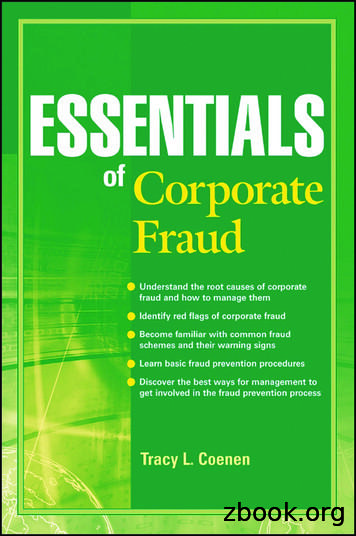Distributed Systems Essentials: Consistency Models And Consensus
Distributed Systems essentials:Consistency models andConsensusSome slides from Michael Freedman andothers
ReplicationqMotivationØØØØPerformance EnhancementEnhanced availabilityFault toleranceScalability§qtradeoff between benefits of replication and work required to keepreplicas consistentRequirementsØMemory Consistency (*not* Consistency in ACID)§§ØDepends upon applicationRequests for different replicas of the same logical data item shouldnot obtain different resultsReplica transparency desirable for most applications2
Consistency ModelsnConsistency Model is a contract between processes and adata storennnNeeded for understanding how concurrent reads andwrites behave with respect to shared dataRelevant for shared memory multiprocessorsnnif processes follow certain rules, then store will work “correctly”cache coherence algorithms; memory consistency modelsShared databases, filesnnindependent operationstransactions3
What is consistency?qConsistency model:ØqA constraint on the system state observable byapplicationsExamples:ØLocal/disk memory :write x 5ØSingle object consistency, alsocalled “coherence”read x (should be 5)timeDatabase:x: x 1; y: y-1assert(x y const)Consistency across 1 objectstime
Consistency challengesnConsistency is hard in (distributed) systems:nnnnData replication (caching)ConcurrencyFailuresNo right or wrong consistency modelsnTradeoff between ease of programmability and efficiency
Example application programCPU 1CPU 0READ/WRITEREAD/WRITEMemory systemx 1If y 0critical sectionqIs this program correct?y 1If x 0critical section
Examplex 1If y 0critical sectionnnnCPU0’s instruction stream: W(x) R(y)CPU1’s instruction stream: W(y) R(x)Enumerate all possible inter-leavings:nnnnny 1If x 0critical sectionW(x)1 R(y)0 W(y)1 R(x)1W(x)1 W(y)1 R(y)1 R(x)1W(x)1 W(y)1 R(x)1 R(y)1 .None violates mutual exclusion
An example distributed shared memoryqqqEach node has a local copy of stateRead from local stateSend writes to the other node, but do not wait
Consistency challenges: exampleW(x)1W(y)1x 1If y 0critical sectiony 1If x 0critical section
Does this work?W(x)1R(y)0x 1If y 0critical sectionW(y)1R(x)0y 1If x 0critical section
What went wrong?W(x)1W(y)1R(x)0R(y)0CPU0 sees:W(x)1R(y)0CPU1 sees:W(y)1R(x)0
Linearizability example
Sequential Consistency - 1Sequential consistency: the result of any execution is the same as if the read andwrite operations by all processes were executed in some sequential order and theoperations of each individual process appear in this sequence in the order specifiedby its program [Lamport, 1979].Note: Any valid interleaving is legal but all processes must see the same interleaving.a)b)P3 and P4 disagreeon the order of the writesA sequentially consistent data store.A data store that is not sequentially consistent.14
Sequential Consistency - 2Process P1Process P2Process P3x 1;print ( y, z);y 1;print (x, z);z 1;print (x, y);x 1;print (y, z);y 1;print (x, z);z 1;print (x, y);x 1;y 1;print (x,z);print(y, z);z 1;print (x, y);y 1;z 1;print (x, y);print (x, z);x 1;print (y, z);y 1;x 1;z 1;print (x, z);print (y, z);print (x, y);Prints: 001011Prints: 101011Prints: 010111Prints: 111111(a)(b)(a)-(d) are all legal interleavings.(c)(d)15
Linearizability vs. SequentialConsistency16
Causal consistencynPartial order: only causally related ops seenthe same order everywherennnn means replicas eventually convergeConcurrent ops may be ordered differentlyPro: better performance/concurrencyCons: Need to reason about concurrency
Causal consistency
In a nutshellnStrict consistency: total order, real-time guarantees over transactionsnLinearizability: total order, real-time guarantees over operationsnSequential consistency: total order program ordernnCausal consistency: Causally ordered operations ( refers to eventualagreement)Eventual consistency: we eventually agree
Figure from Martin Klepmann22
CAP theoremnConsistency, Availability, Partition resilientnnnGeneral/intuitive but not precisennCan only have two of threeProposed by Brewer (2000), and proved/formalized byGilbert and Lynch (2002)Brewer in 2012: “Misleading because it tended tooversimplify the tension between the elve-years-later-howthe-rules-have-changedStill CAP was influentialnBASE vs. ACID, NoSQL, 23
CONSENSUS INTRO
What do clients see?nDistributed stores use replicationnnFault tolerance and scalabilityDoes replication necessitate inconsistency?nHarder to program, confusing for clients
ProblemnnHow to reach consensus/dataconsistency in distributed system thatcan tolerate non-malicious failures?We saw some consistency models –how to implement them?
Another perspectivenLock is the easiest way to manageconcurrencynnnMutex and semaphore.Read and write locks.In distributed system:nnNo master for issuing locks.Failures.
3 Consistency Models n Consistency Model is a contract between processes and a data store n if processes follow certain rules, then store will work "correctly" n Needed for understanding how concurrent reads and writes behave with respect to shared data n Relevant for shared memory multiprocessors n cache coherence algorithms; memory consistency models n Shared databases, files
Essentials of Knowledge Management,Bryan Bergeron Essentials of Patents,Andy Gibbs and Bob DeMatteis Essentials of Payroll Management and Accounting,Steven M.Bragg Essentials of Shared Services,Bryan Bergeron Essentials of Supply Chain Management,Michael Hugos Essentials of Trademarks and Unfair Competition,
Types of Eventual Consistency 57 Casual Consistency 57 Read-Your-Writes Consistency 57 Session Consistency 58 Monotonic Read Consistency 58 Monotonic Write Consistency 58 Four Types of NoSQL Databases 59 Key-Value Pair Databases 60 Keys 60 Values 64 Differences Between Key-Value and Relational Databases 65 Document Databases 66
Distributed Database Design Distributed Directory/Catalogue Mgmt Distributed Query Processing and Optimization Distributed Transaction Mgmt -Distributed Concurreny Control -Distributed Deadlock Mgmt -Distributed Recovery Mgmt influences query processing directory management distributed DB design reliability (log) concurrency control (lock)
Consistency: The consistency property guarantees that an operation or a transac-tion is performed atomically and leaves the systems in a consistent state, or fails in-stead. This is equivalent to the atomicity and consistency properties (AC) of the ACID (Atomicity, Consistency, Isolation and Durability) semantics in relational database
Cybersecurity Essentials Introduction to Cybersecurity Introduction to IoT Networking Essentials Entrepreneurship Explore Introduction to exciting opportunities in technology. Preparation for entry level positions. Networking CCNP R&S: Switch Route TShoot Digital Essentials IT Essentials NDG Linux Essentials PCAP: Programming Essentials in Python
Essentials of Financial Risk Management, Karen A. Horcher Essentials of Intellectual Property, Paul J. Lerner and Alexander I. Poltorak Essentials of Knowledge Management, Bryan Bergeron Essentials of Patents, Andy Gibbs and Bob DeMatteis Essentials of Payroll Management and Accounting, Steven M. Bragg
ADM SR Glo Horse 50# 29.95 ADM Alliance Nutrition ADM ADM Staystrong MNRL 40# 26.18 ADM Alliance Nutrition ADM AE Book Herbal Remedies Book 3.41 Animal Essentials Animal Essentials AE Colon Rescue (Phytomucil) 1z 9.18 Animal Essentials Animal Essentials AE Colon Rescue (Phytomucil) 4z 28.18 Animal Essentials Animal Essentials . APP Dry Cat .
Both the ISO 14001 and the Responsible Care requirements shall be included in order for an organization to receive certification of its RC14001 management system. ISO 14001 This Technical Specification document includes relevant provisions of the text of international standard ISO-14001:2004 – Environmental Management Systems. The text of ISO14001 is the first set of requirements in each .























